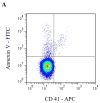Microparticle analysis in disorders of hemostasis and thrombosis
- PMID: 25704723
- PMCID: PMC4545474
- DOI: 10.1002/cyto.a.22647
Microparticle analysis in disorders of hemostasis and thrombosis
Abstract
Microparticles (MPs) are submicron vesicles released from the plasma membrane of eukaryotic cells in response to activation or apoptosis. MPs are known to be involved in numerous biologic processes, including inflammation, the immune response, cancer metastasis, and angiogenesis. Their earliest recognized and most widely accepted role, however, is the ability to promote and support the process of blood coagulation. Consequently, there is ongoing interest in studying MPs in disorders of hemostasis and thrombosis. Both phosphatidylserine (PS) exposure and the presence of tissue factor (TF) in the MP membrane may account for their procoagulant properties, and elevated numbers of MPs in plasma have been reported in numerous prothrombotic conditions. To date, however, there are few data on true causality linking MPs to the genesis of thrombosis. A variety of methodologies have been employed to characterize and quantify MPs, although detection is challenging due to their submicron size. Flow cytometry (FCM) remains the most frequently utilized strategy for MP detection; however, it is associated with significant technological limitations. Additionally, preanalytical and analytical variables can influence the detection of MPs by FCM, rendering data interpretation difficult. Lack of methodologic standardization in MP analysis by FCM confounds the issue further, although efforts are currently underway to address this limitation. Moving forward, it will be important to address these technical challenges as a scientific community if we are to better understand the role that MPs play in disorders of hemostasis and thrombosis.
Keywords: coagulation; flow cytometry; hemostasis; microparticles; microvesicles; thrombosis.
© 2015 International Society for Advancement of Cytometry.
Conflict of interest statement
The authors have no conflicts of interest to disclose.
Figures





Similar articles
-
Circulating tissue factor-exposing microparticles.Thromb Res. 2008;122 Suppl 1:S47-54. doi: 10.1016/S0049-3848(08)70019-7. Thromb Res. 2008. PMID: 18691500 Review.
-
Platelet microparticles and vascular cells interactions: a checkpoint between the haemostatic and thrombotic responses.Platelets. 2008 Feb;19(1):9-23. doi: 10.1080/09537100701817232. Platelets. 2008. PMID: 18231934 Review.
-
Microparticles in hemostasis and thrombosis.Circ Res. 2011 May 13;108(10):1284-97. doi: 10.1161/CIRCRESAHA.110.233056. Circ Res. 2011. PMID: 21566224 Free PMC article. Review.
-
Imaging flow cytometry elucidates limitations of microparticle analysis by conventional flow cytometry.Cytometry A. 2014 Sep;85(9):756-70. doi: 10.1002/cyto.a.22494. Epub 2014 Jun 5. Cytometry A. 2014. PMID: 24903900
-
Super-resolved calibration-free flow cytometric characterization of platelets and cell-derived microparticles in platelet-rich plasma.Cytometry A. 2016 Feb;89(2):159-68. doi: 10.1002/cyto.a.22621. Epub 2015 Mar 21. Cytometry A. 2016. PMID: 25808430
Cited by
-
Platelets and extracellular vesicles and their cross talk with cancer.Blood. 2021 Jun 10;137(23):3192-3200. doi: 10.1182/blood.2019004119. Blood. 2021. PMID: 33940593 Free PMC article. Review.
-
Microvesicle phenotypes are associated with transfusion requirements and mortality in subjects with severe injuries.J Extracell Vesicles. 2015 Dec 17;4:29338. doi: 10.3402/jev.v4.29338. eCollection 2015. J Extracell Vesicles. 2015. PMID: 26689982 Free PMC article.
-
Microparticles formed during storage of red blood cell units support thrombin generation.J Trauma Acute Care Surg. 2018 Apr;84(4):598-605. doi: 10.1097/TA.0000000000001759. J Trauma Acute Care Surg. 2018. PMID: 29251713 Free PMC article.
-
From Classical Laboratory Parameters to Novel Biomarkers for the Diagnosis of Venous Thrombosis.Int J Mol Sci. 2020 Mar 11;21(6):1920. doi: 10.3390/ijms21061920. Int J Mol Sci. 2020. PMID: 32168924 Free PMC article. Review.
-
Platelet-derived microvesicles (PMVs) in cancer progression and clinical applications.Clin Transl Oncol. 2023 Apr;25(4):873-881. doi: 10.1007/s12094-022-03014-3. Epub 2022 Nov 23. Clin Transl Oncol. 2023. PMID: 36417084 Review.
References
-
- Chargaff E, West R. The biological significance of the thromboplastic protein of blood. J Biol Chem. 1946;166:189–97. - PubMed
-
- Wolf P. The nature and significance of platelet products in human plasma. Br J Haematol. 1967;13:269–88. - PubMed
-
- Tesse A, Martínez MC, Meziani F, Hugel B, Panaro MA, Mitolo V, Freyssinet JM, Andriantsitohaina R. Origin and Biological Significance of Shed-Membrane Microparticles. Endocrine, Metabolic & Immune Disorders - Drug Targets. 2006;6:287–94. - PubMed
-
- Thaler J, Ay C, Pabinger I. Clinical significance of circulating microparticles for venous thromboembolism in cancer patients. Hamostaseologie. 2012;32:127–31. - PubMed
Publication types
MeSH terms
Grants and funding
LinkOut - more resources
Full Text Sources
Other Literature Sources
Medical
Miscellaneous

